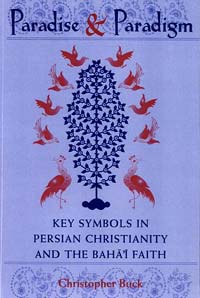
|
Abstract: Study of Bahá'í and Christian symbology, the "first academic monograph comparing Christianity and the Bahá'í Faith." Notes: Second edition, 2012: this document is an updated version of the SUNY book published in 1999, which was itself an updated version of a dissertation at the University of Toronto, 1996. |
Paradise and Paradigm:
Key Symbols in Persian Christianity and the Bahá'í Faith
by Christopher Buck
1999
 click for larger cover |
Published by the State University of New York Press Distributed by Kalimat Press as Studies in the Babi and Bahá'í Religions, Volume Ten see publisher's website www.kalimat.com |
Click here to download it: buck_paradise_paradigm.pdf.
- This volume is certainly the best comparative work on the Bahá'í Faith and another religious tradition that has yet appeared, and may serve as a model for future such studies. — Collins, World Order (2002).
- As a piece of Bahá'í scholarship it remains unparalleled. In terms of academic comparative efforts involving the Bahá'í Faith, Buck's book is a pioneering work. — Grolin, H-Net (2000).
- This is a provocative, ground-breaking work. Its careful attention to methodology and its attempt to work through the project with the attitude of experimentation will provide a significant impulse to the study of religion. — Rippin, U Toronto Q (2002).
- Paradise and Paradigm is a goldmine of information about two relatively little studied but fascinating developments in Middle Eastern religious history. — Renard, MESA Bulletin (2000).
- Paradise and Paradigm opens new possibilities for comparison and suggests new methodological approaches. — McVey, International Journal of Middle East Studies (2003).
- "This is an extremely powerful contribution to an important part of comparative religions, and will establish its author as a major academic scholar. Its purpose is to compare the symbologies of early pre-Muslim Persian (Sassanian) Christianity, especially in the work of Ephrem the Syrian, with the late nineteenth century Persian religion of the Bahai's, post-Islamic, as centered in the writings of Bahá'u'lláh. The symbolic center of the comparison is the family of symbols having to do with paradise. Both in its methodology and its scholarly treatments of Persian Christianity and Bahá'í Faith, the book is insightful. It gives its subjects allure." — Robert Cummings Neville, Boston University, author of The Truth of Broken Symbols.
- In a novel approach that the author terms "symbolic paradigm analysis," Paradise and Paradigm offers a "theoretically modular" systematic comparison of two "Persian" religions: early Syriac Christianity as the foundation of the East Syrian "Church of the East" (the Nestorian Church of Persia) and the Bahá'í Faith, a new world religion. The author compares the hymns of the greatest poet of early Christianity, Saint Ephrem the Syrian, and the richly imagistic writings of the founder of the Bahá'í religion, Bahá'u'lláh. The book employs an original analytic technique in the creation of "symbolic profiles" constructed on Ninian Smart's dimensional model of religion. As Buck skillfully demonstrates, formal similarities between any two religions are best comprehended in terms of paradigmatic differences, which nuance all parallels through a process of symbolic transformation. Buck also shows the communal reflexivity of paradise imagery in representing the ideal faith-community in both traditions.
"This work is a model of comparison, an eye-opener regarding the interesting Syriac Christian traditions, and quite a useful and revealing account of the Bahá'í." — William Paden, University of Vermont, author of Religious Worlds: The Comparative Study of Religion.
|
|